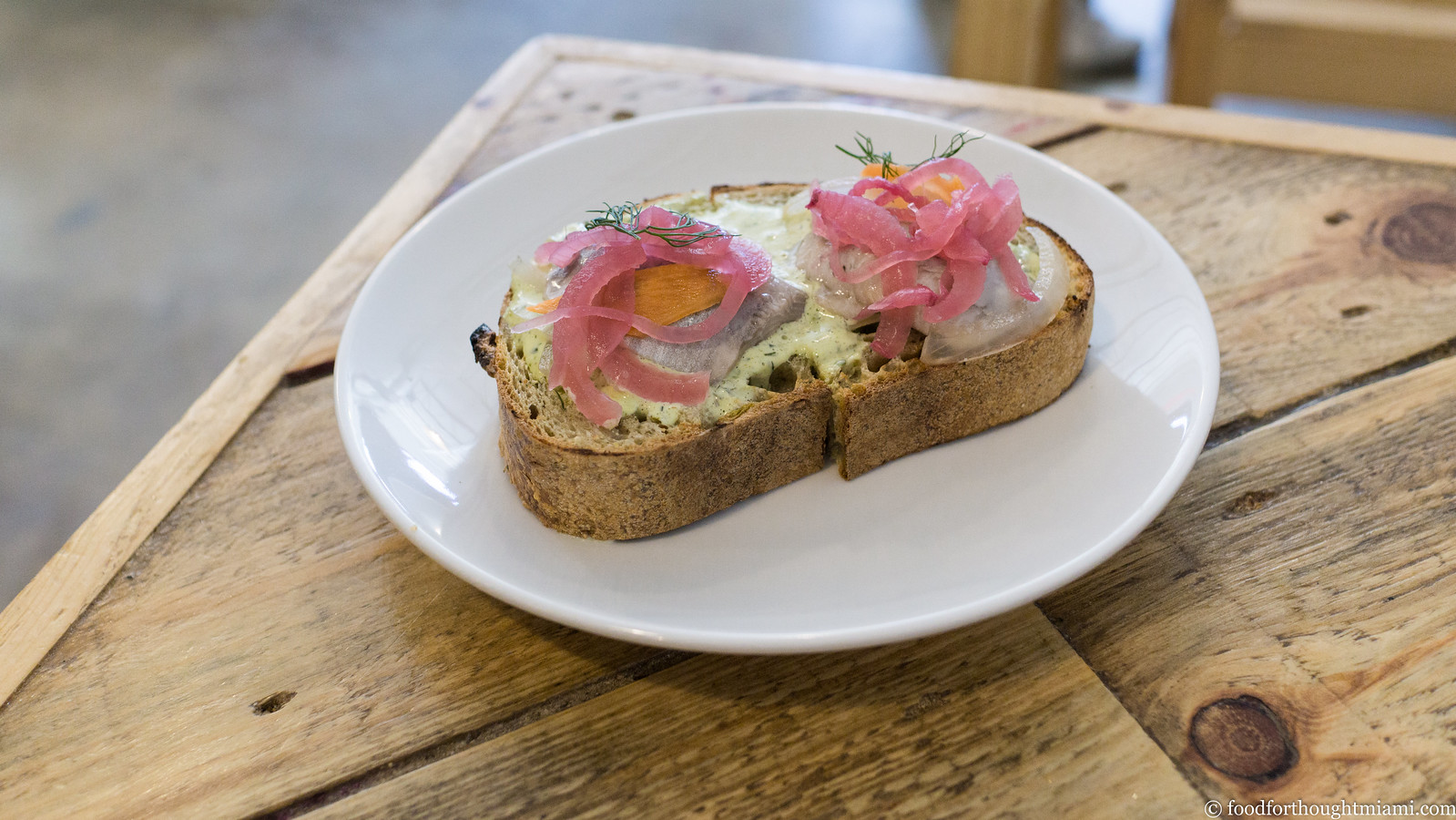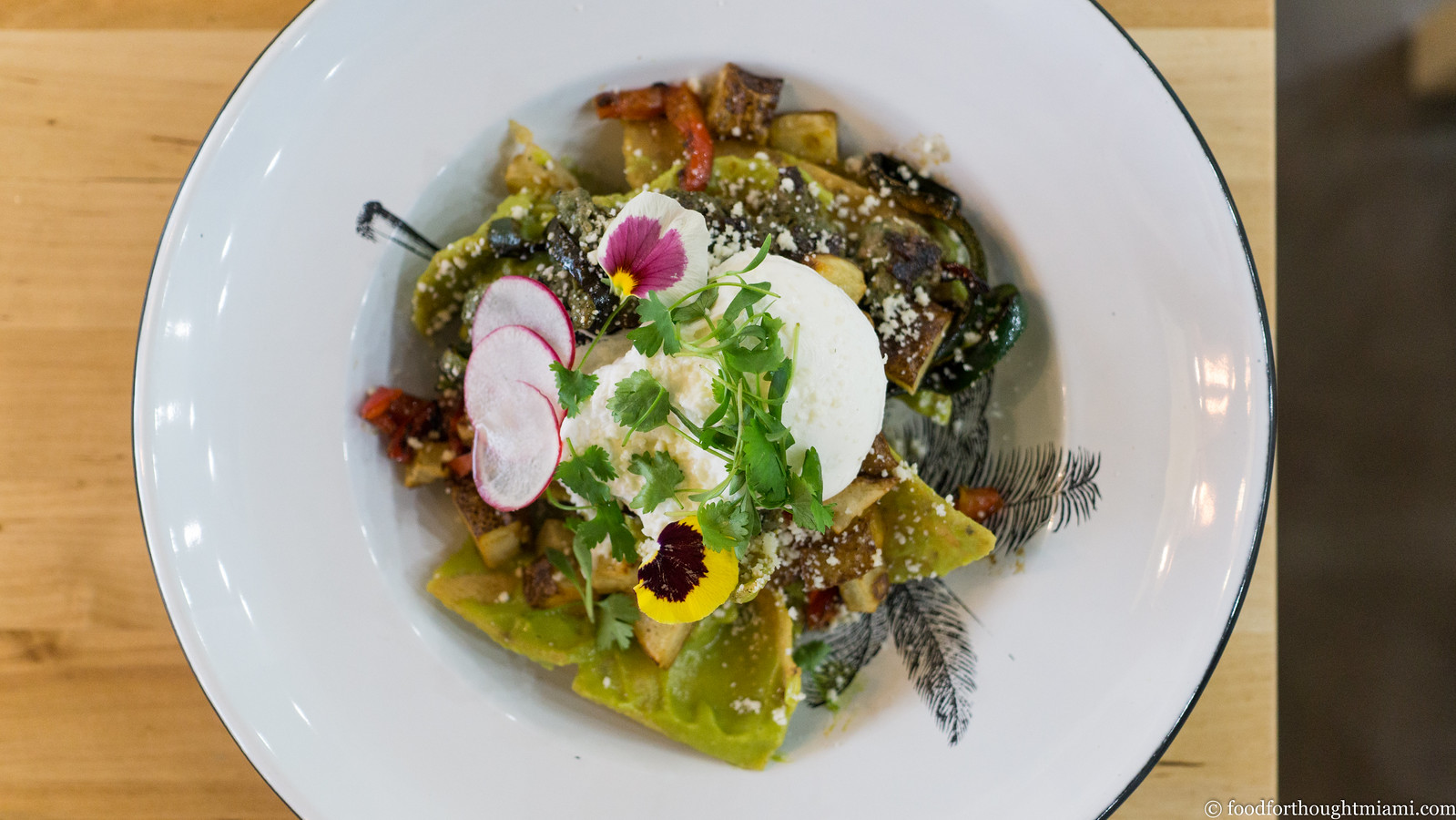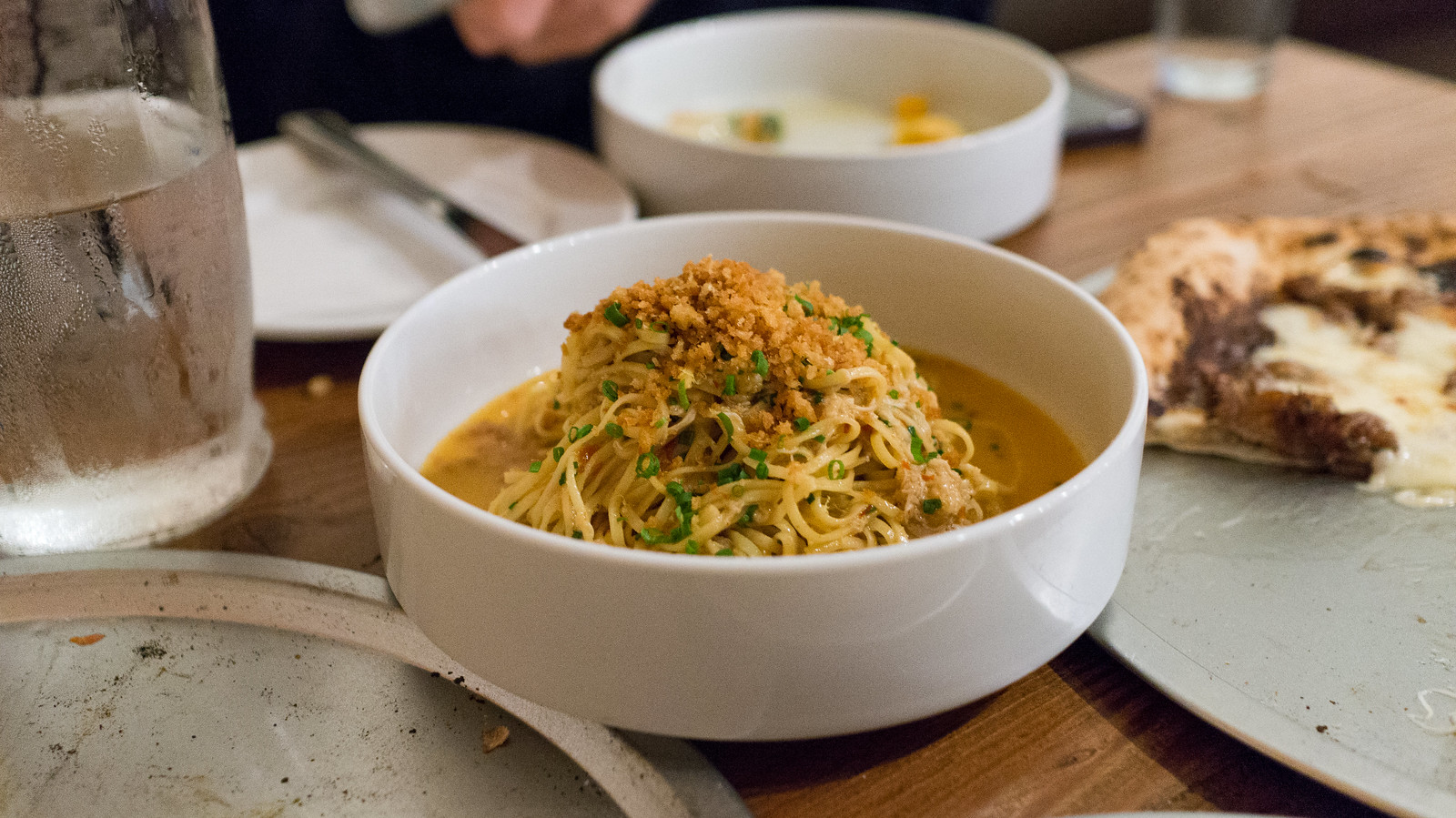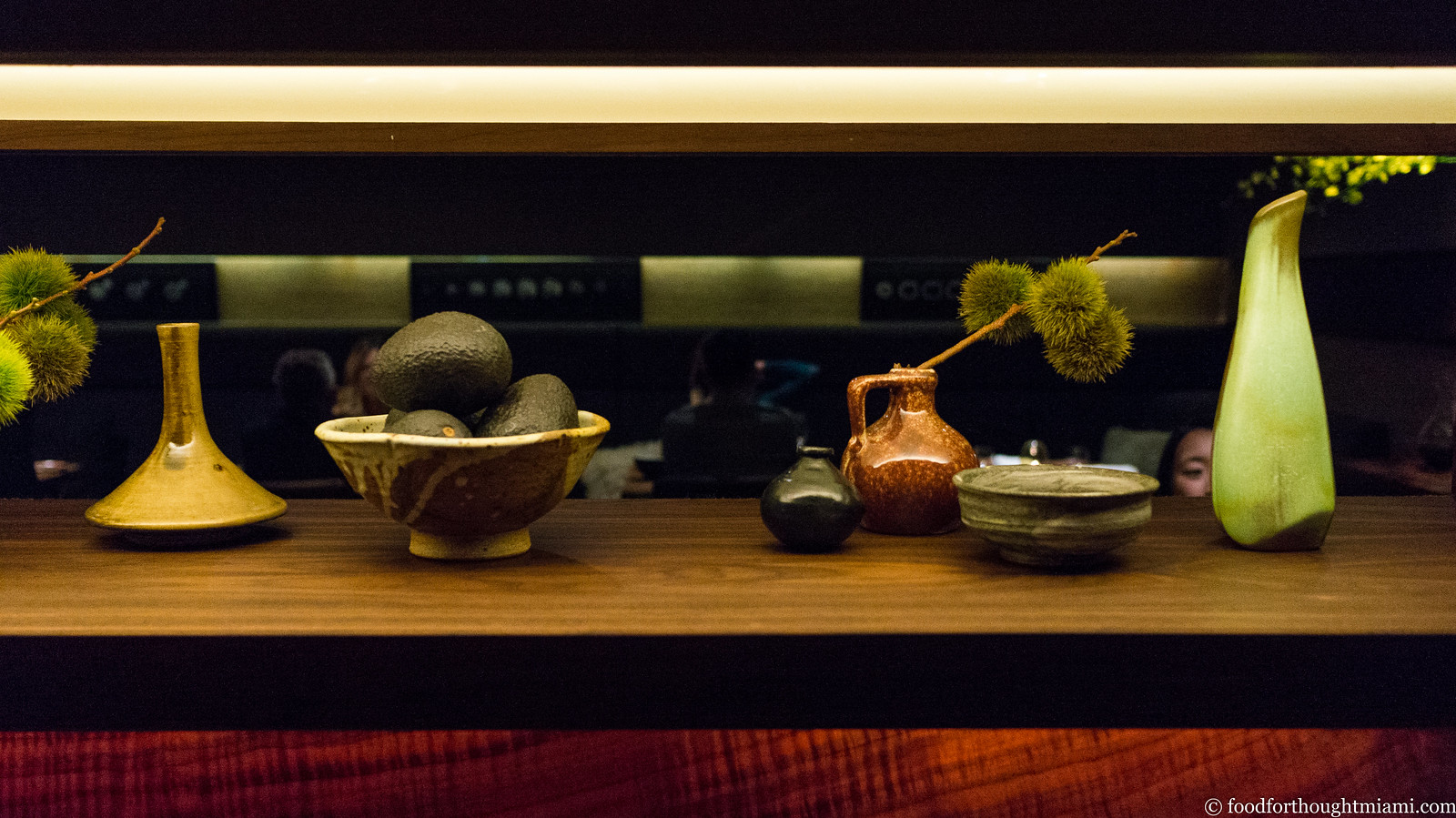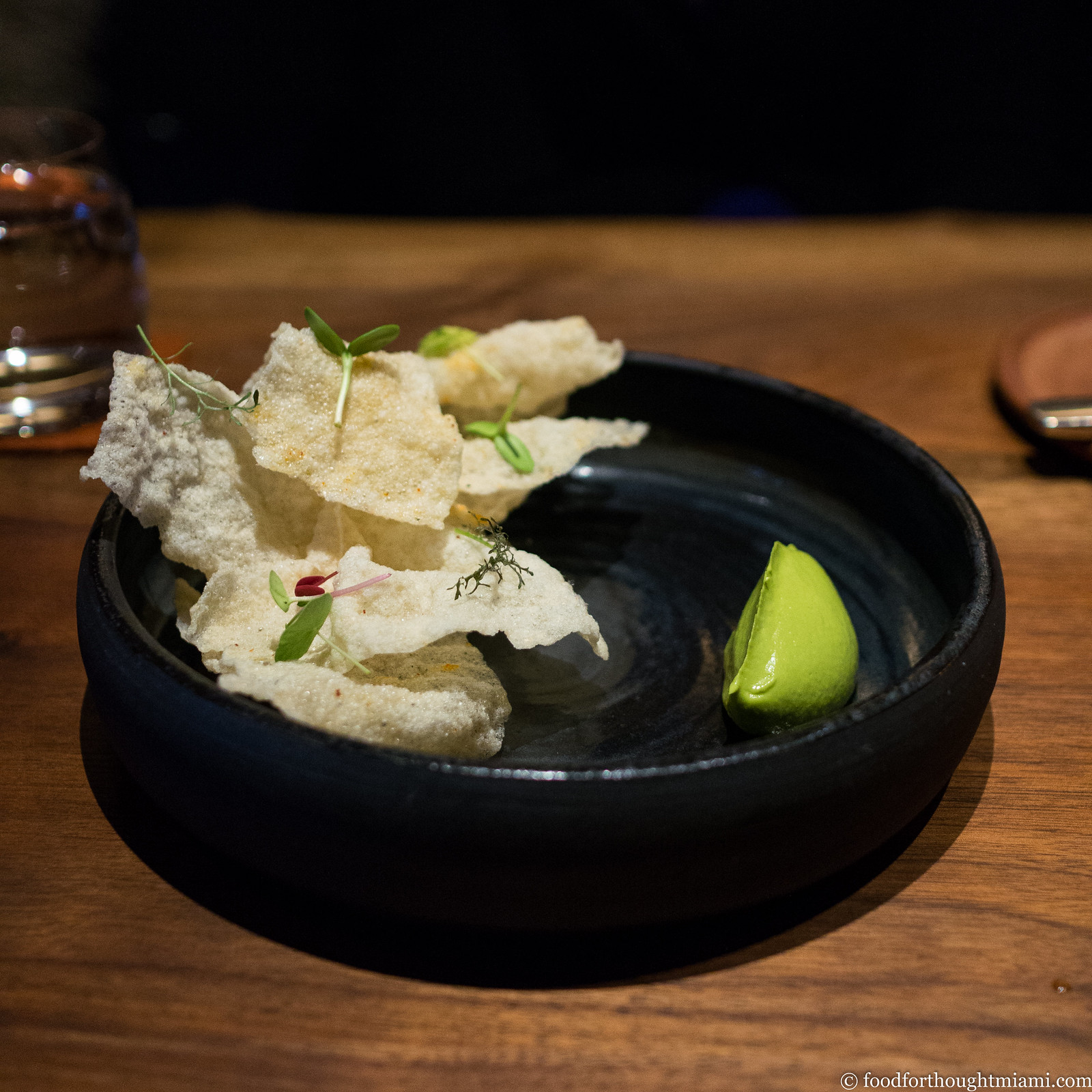▼
Monday, September 21, 2015
best thing i ate last week: schmaltz herring toast at Zak the Baker
It was the first thing I ate at Zak the Baker when the Wynwood café opened last May: a toasted slab of his fantastically crusty, naturally leavened multigrain bread, topped with slick, fatty brined schmaltz herring and pickled onions. On that first visit, it was paired with a 10 a.m. vodka shot which Zak rightfully insisted was an essential accompaniment.
This past Sunday morning, there was mercifully no hard liquor, but there was that same delicious fish, that same delicious bread, those same tart onions, though a pickle-infused aioli substituted for the creamy creme fraiche of that first visit. Still mighty good. And the best thing I ate last week. Pro tip: ZTB gets crazy busy with Sunday brunchers, but still keeps baker's hours, and opens at 7 a.m. If you can rouse yourself early, you may be able to squeeze in before the crowds.
Runner up: a classic from chef Michelle Bernstein's repertoire, on the menu at her Miami Beach restaurant, Seagrape: a delicately fried squash blossom stuffed with shrimp mousseline, served over a bed of creamy corn grits and dappled with a rich seafood nage.
Saturday, September 19, 2015
a message from the future
A couple weeks ago Eater Miami asked me, "What do you think the future of dining looks like?" Some of my comments ran yesterday along with responses from several other locals as part of a series of "Future Week" stories across the Eater network. It may not surprise you that I actually had a bit more to say on the subject. Here's an expanded version of my thoughts on the future of dining, particularly in South Florida.
There is already movement in this direction, and the political push for minimum wage increases plus the shortage of line cooks will create increasing pressure to even out front-of-house and back-of-house compensation. (Sooner or later the light bulb will go off that there's a connection between the low wages for kitchen employees and their scarcity). Putting service staff on salary without a tip credit will be a big shift, but possibly a necessary one.
On my last visits to the Bay Area, several places were either adding a "service charge" or doing "service included" bills (Comal and Ippuku in Berkeley, Camino in Oakland). There have been some interesting success stories, including a couple places that give long-term employees a small share of ownership. Just this week, Tom Colicchio announced he is going to a no-tip, price-inclusive-of-service program during lunch service at Craft. There have also been places that tried, and ultimately balked, at using all-inclusive, no-tip pricing (Aster in San Francisco comes to mind).
In Miami, anyway, we're already accustomed to seeing "gratuity added" (or not seeing it clearly marked on the bill, but still having it done!). It would make little difference to the diner if instead, it was "service included" that gets shared with BOH and FOH, but it would require a change in how the restaurants operate.
One arguable financial upside to making this shift for restaurateurs: it will mitigate the risk of wage violation lawsuits that often arise from asserted non-compliance with tip credit requirements. Perhaps not coincidentally, Colicchio's restaurants have twice been sued for wage violations – once back in 2008 (a case that was settled), and more recently this year in connection with 'wichCraft (he pointedly denies the latest allegations). These lawsuits can be high-stakes stuff: in 2008, Jean-Georges Vongerichten paid $1.75 million to settle wage claims; in 2009 Nobu paid $2.5 million for similar claims; in 2012, Mario Batali and Joe Bastianich's restaurants paid $5 million in a settlement.
See 1. Increasing wages will put even more pressure on thin margins; eventually the cost of dinner will have to go up.
See 1, 2. If the cost of labor is going up, and you have limited ability to raise prices, then you'll have to figure out how to get by with less employees. I expect there will be more "fast casual" type places, and that it will be increasingly difficult to successfully operate a moderately priced sit-down restaurant. Miami chef Alberto Cabrera recently made this shift, turning his Coral Gables restaurant Bread & Butter from a sit-down place into Little Bread, with counter service sandwiches and bowls, and I think it will prove to be a good move for him. Big picture, though, this bums me out, and I hope I'm wrong. Some of my favorite restaurants are the mid-range places where you can find interesting, ambitious food without it being a hundred dollar meal to pay for a million dollar build-out. I worry these will become an endangered species.
Everything can't be in Wynwood, South Beach or Brickell. And there are huge parts of Miami-Dade County with lots of population density, lower rents, and little restaurant competition other than chains, like Doral and Kendall. Closer to Miami's urban core, you're already seeing it happen in Edgewater (Mignonette) and the Upper East Side (Vagabond, Cena by Michy, Blue Collar, etc.), and I think the push northward up Biscayne Boulevard will continue. And maybe just a bit west too: Little Haiti?
Some of them may be great. They all won't be. And it may prove tough to fill so many big dining rooms, even if you''re a "celebrity chef." Just ask Fabio Vivani. Or Tony Mantuano. Or Geoffrey Zakarian. Or – hot off the presses – Masaharu Morimoto, who announced just yesterday that he is closing his restaurant in the Shelborne on South Beach after exactly a year. Or ....
1. Tipping may become a thing of the past.
There is already movement in this direction, and the political push for minimum wage increases plus the shortage of line cooks will create increasing pressure to even out front-of-house and back-of-house compensation. (Sooner or later the light bulb will go off that there's a connection between the low wages for kitchen employees and their scarcity). Putting service staff on salary without a tip credit will be a big shift, but possibly a necessary one.
On my last visits to the Bay Area, several places were either adding a "service charge" or doing "service included" bills (Comal and Ippuku in Berkeley, Camino in Oakland). There have been some interesting success stories, including a couple places that give long-term employees a small share of ownership. Just this week, Tom Colicchio announced he is going to a no-tip, price-inclusive-of-service program during lunch service at Craft. There have also been places that tried, and ultimately balked, at using all-inclusive, no-tip pricing (Aster in San Francisco comes to mind).
In Miami, anyway, we're already accustomed to seeing "gratuity added" (or not seeing it clearly marked on the bill, but still having it done!). It would make little difference to the diner if instead, it was "service included" that gets shared with BOH and FOH, but it would require a change in how the restaurants operate.
One arguable financial upside to making this shift for restaurateurs: it will mitigate the risk of wage violation lawsuits that often arise from asserted non-compliance with tip credit requirements. Perhaps not coincidentally, Colicchio's restaurants have twice been sued for wage violations – once back in 2008 (a case that was settled), and more recently this year in connection with 'wichCraft (he pointedly denies the latest allegations). These lawsuits can be high-stakes stuff: in 2008, Jean-Georges Vongerichten paid $1.75 million to settle wage claims; in 2009 Nobu paid $2.5 million for similar claims; in 2012, Mario Batali and Joe Bastianich's restaurants paid $5 million in a settlement.
2. Expensive restaurants will become even more expensive.
See 1. Increasing wages will put even more pressure on thin margins; eventually the cost of dinner will have to go up.
3. Lower end restaurants will look for ways to reduce staff.
See 1, 2. If the cost of labor is going up, and you have limited ability to raise prices, then you'll have to figure out how to get by with less employees. I expect there will be more "fast casual" type places, and that it will be increasingly difficult to successfully operate a moderately priced sit-down restaurant. Miami chef Alberto Cabrera recently made this shift, turning his Coral Gables restaurant Bread & Butter from a sit-down place into Little Bread, with counter service sandwiches and bowls, and I think it will prove to be a good move for him. Big picture, though, this bums me out, and I hope I'm wrong. Some of my favorite restaurants are the mid-range places where you can find interesting, ambitious food without it being a hundred dollar meal to pay for a million dollar build-out. I worry these will become an endangered species.
4. More independent restaurants in less trendy neighborhoods.
Everything can't be in Wynwood, South Beach or Brickell. And there are huge parts of Miami-Dade County with lots of population density, lower rents, and little restaurant competition other than chains, like Doral and Kendall. Closer to Miami's urban core, you're already seeing it happen in Edgewater (Mignonette) and the Upper East Side (Vagabond, Cena by Michy, Blue Collar, etc.), and I think the push northward up Biscayne Boulevard will continue. And maybe just a bit west too: Little Haiti?
5. 50% of the big-name chef restaurants that are opening in Miami won't be around after two years.
Some of them may be great. They all won't be. And it may prove tough to fill so many big dining rooms, even if you''re a "celebrity chef." Just ask Fabio Vivani. Or Tony Mantuano. Or Geoffrey Zakarian. Or – hot off the presses – Masaharu Morimoto, who announced just yesterday that he is closing his restaurant in the Shelborne on South Beach after exactly a year. Or ....
Monday, September 14, 2015
best thing i ate last week: chilaquiles verdes at Centro Taco
My first visit to Centro Taco was in late July, the day after they opened. And I was pretty excited by what I found: house-made tortillas rolled out at a workstation in the middle of the dining room, serving as vehicles for toppings which paid more heed to flavor than rigid authenticity. There were gator pibil tacos, duck carnitas tacos, and best of all, a gordita topped with Haitian style griots and pikliz that was the best thing I ate that week.
I finally got back for a second visit this past Saturday, when Chef Richard Hales features a brunch menu in much the same spirit. My favorite of the few things I tried was his version of chilaquiles. Fried tortilla shards are softened with salsa verde,[1] and serve as the base for a potato and pepper hash, poached egg, and some Proper Sausages chorizo verde flecked with green chiles and herbs. Slivered radishes, fresh cilantro, and yeah, some flower petals – because Richard's a sensitive vegan who likes flowers now – finish the dish. It was the best thing I ate last week.
(You can see all my pictures in this Centro Taco - Miami flickr set).
[1] In my mind anyway, there's a weird affinity between Mexican chilaquiles and Jewish matzo brei. But I suppose lots of food cultures use the same trick of refreshing stale breadstuffs with a soak in some flavorful liquid or egg: Spanish migas, French pain perdu.
Wednesday, September 9, 2015
best thing i ate last week: angel hair with crab, calabrian chili and lemon breadcrumbs at Proof
I don't often go to Italian restaurants, for reasons I've previously expressed. Put in less vulgar terms: it's not so easy to find it done much better than I can do it at home. So when I do go out for Italian, I go to a place like Proof Pizza & Pasta. The modest name belies the seriousness of the cooking here. The pizzas are very good, but the pastas are easily some of the best in town, rivaled only by Macchialina and perhaps Scarpetta (where I haven't been since Nina Compton left).
Case in point: their angel hair with crab. Angel hair is usually the most insipid and pointless of pastas, but here the noodles still have a substantial texture despite their diminutive width, making them an ideal vehicle for the sweet crabmeat. It all swims in an intense crustacean sauce somewhere between broth and bisque, with some Calabrian chiles for some zing, and lemon breadcrumbs for brightness and texture. It was the best thing I ate last week.
All the pastas at Proof are pretty consistently excellent, but I'd also suggest you not sleep on the bucatini with uni and roasted cauliflower, which was a new addition to the menu on my last visit.
(That picture is from about a year ago, though the dish remains the same; you can see all my pictures in this Proof Pizza & Pasta - Miami flickr set).
Runners up: this excellent house-made charcuterie board at Edge Steak and Bar in Brickell; this cured and oil-poached local tuna and kimchi reuben from Josh's Deli.
Tuesday, September 8, 2015
Coi - San Francisco
There's a passage in Daniel Patterson's book "Coi: Stories and Recipes" that I found almost painfully evocative. The chef was writing about his first restaurant in Sonoma, and the turning of the season from summer to fall:
It was when the rains came, and the tourists went away. The first year the bills piled up on the mantelpiece at home, one pile per week, carefully bound with a rubber band, the total owed marked on a Post-it on top. At first there were two, then four and later eight piles, sitting there as a constant reminder of our empty dining room. The rain cut off roads and flooded fields, seeping into our subterranean bedroom at home, filling it with the smell of damp concrete and mold. Subsequent years were never as bad as the first, but every fall after that, as the days shortened and our bank account dwindled, my heart broke a little as we dug in for an isolated, depressing winter. That was some time ago, but the scars still remain. Every year, even now, when I step outside and feel that the light has changed, that it is fall and that summer is gone, I fight down a rising panic. It will be all right, I tell myself, over and over, until eventually I believe it enough to keep going.Coi is one of the more unusual "cookbooks" I've read lately. It's not so much the format, which pairs a thoughtful one-page essay with each recipe, nor even the initially somewhat distracting decision to put all the ingredients and quantities for those recipes in a separate index at the back of the book. And while Patterson can wax seriously eloquent about what inspires his dishes and how to cook them, it wasn't entirely that either. What was so striking was his willingness to provide these personal and often brutally candid insights into the fears and frustrations of being a professional chef.
The restaurant business is a weird and particularly tough one that seems to be constantly teetering between success and failure, both on a macro and micro level. In a sea of competition, it's hard enough to figure out what's going to capture the dining audience's interest. Then you actually have to make it work. Even when you do, this year's hot-spot can quickly turn into next year's has-been. Get all the big things right, and you're still only as good as your last plate: some line cook screws up the seasoning or cooking time on one dish, or your server is having a lousy day, and a customer leaves with a bad impression that you may never have a second chance to remedy.
From reading his book and following his career, it's clear Patterson recognizes and, in his own way, embraces this dance on the edge. In the essay about his "beet rose," an almost absurdly labor-intensive dish in which slivers of roasted beet are assembled by hand to resemble the petals of a rose, then paired with an aerated yogurt and rose petal granita, he describes it like this:
When a dish is right, there is synchronicity between form and substance, idea and execution. This is a dish that was meant to be challenging to make, impractical to reproduce. There is something about its unreasonableness which makes it more impactful. For it to work, everything has to be perfect. ... But I came to love it most for what it represented to me: intuitive, handmade cooking. Each rose is a little different, and I can pick out who made which one every night. The seasoning is finely tuned, wobbling on the edge of sweet and savory, always close to tumbling into failure.That sounds a little crazy, but yeah, I'd like to experience that. Because as good a writer as he is, Patterson is pretty universally recognized to be an even better chef. And yet I'd never paid a visit to the restaurant from which the book takes its name. My travels to the West Coast are almost always with family, which means my opportunities to do tasting menus are limited. And other, shinier objects always seemed to beckon. Then a month ago, Patterson announced that he was stepping down as executive chef at Coi and handing over the reigns to chef Matthew Kirkley in January. It was a surprising announcement: first, because Patterson's work at Coi has been so highly regarded, but even more so because it has been so definitively Patterson's restaurant, and his style of cooking is so personal, that the two seemed inseparable.[1]
We already had a trip to San Francisco coming up. So this would likely be the last chance, for the foreseeable future anyway, to catch Patterson in the kitchen. I re-jiggered the agenda, talked the family into doing a tasting menu dinner,[2] and booked a reservation at Coi. When they asked me what kind of restaurant it is, I wasn't sure exactly how to answer. What I knew is that it's a tasting menu format (but much more restrained than the 20+ course bacchanals like Saison); that it's got some locavore / forager sensibilities, but is not wedded to them; and that the cooking uses, but does not seem defined by, contemporary techniques and processes. This undefinability is also something of which Patterson is acutely self-aware:
When it comes to what a marketing wonk would call 'brand clarity,' we don't do ourselves any favors. ... When someone asks, 'What's the food like?' the best thing I can come up with is, 'Um, hopefully delicious,' my voice rising at the end in a note of uncertainty.Well, let's see.
For this farewell tour of sorts, Patterson has seeded the menu with several "greatest hits," and his "California Bowl" is one of those. It's really just an elevated version of chips and dip using some of the basic tropes of California hippie cuisine: brown rice, avocado and sprouts. But those chips (made from rice cooked down to a paste, dehydrated, then fried like chicharrones) are light and airy and have a tingle of spice, the avocado is whipped until soft as a cloud, and zinging with lime, the tiny greens have bright, fresh, intense flavors.
(You can see all my pictures from the dinner in this Coi - San Francisco flickr set).
(continued ...)

